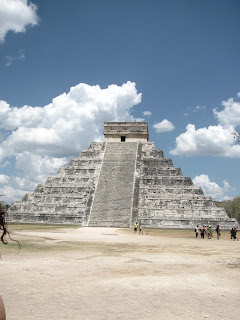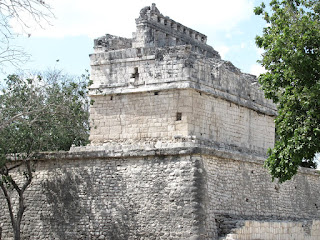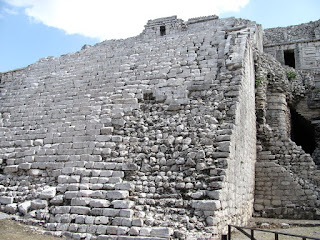Chichen Itza "chee-cha nee-sa" was created by people called the Itzles in 445 BC. About 800 years later, the city was empty. Why the people left is still a mystery.
Chichen Itza is absolutely breathtaking! It is a mystical, magical & mysterious place. I felt a sense of calm and serenity there. It was definitely worth the long bus ride. I hope you enjoy our photos...
Chichen Itza was one of the greatest Mayan centers of the Peninsula of Yucatan. Throughout its nearly 1,000 years history, different peoples have left their mark on this city. The Maya and Toltec vision of the world and the universe is revealed in their artistic works and stone monuments. Several buildings have survived.
In the northern region of the Yucatan peninsula, on a limestone plateau lie the relics of Chichen Itza, once one of the most powerful cities of the Maya. Ruins of the temples of this ancient civilization spread from the Guatemala jungles to the Yucatan. Today, Chichen Itza attracts millions of visitors who come to marvel at the spectacular remains.
 |
El Castillo (The Kukulkan Pyramid)
Possibly the best known construction on Chichen Itza is Kukulkan's Pyramid.
El Castillo (The Kukulkan Pyramid), a square-based, stepped pyramid that is approximately 75 feet tall.
Kukulkan Pyramid was built for astronomical purposes and during the vernal equinox (March 20) and the autumnal equinox (September 21) at about 3pm the sunlight bathes the western balustrade of the pyramid's main stairway.
This causes 7 isosceles triangles to form imitating the body of a serpent roughly 37 yards long that creeps downwards until it joins the huge serpent's head carved in stone at the bottom of the stairway.
Mexican researcher Luis El Arochi calls it "the symbolic descent of Kukulkan" (means the feathered serpent), and believes it could have been connected with agricultural rituals. |



| The Ball Court at Chichén Itzá |
|  The Mayans were great sportsmen and build huge ballcourts to play their games. The Great Ballcourt of Chichén Itzá is 545 feet long and 225 feet wide overall. It has no vault, no discontinuity between the walls and is totally open to the sky. Each end has a raised "temple" area. A whisper from end can be heard clearly at the other end 500 feet away and through the length and breath of the court. The sound waves are unaffected by wind direction or time of day/night. Archaeologists engaged in the reconstruction noted that the sound transmission became stronger and clearer as they proceeded. In 1931 Leopold Stokowski spent 4 days at the site to determine the acoustic principals that could be applied to an open-air concert theater he was designing. Stokowski failed to learn the secret. To this day it has not been explained. The Mayans were great sportsmen and build huge ballcourts to play their games. The Great Ballcourt of Chichén Itzá is 545 feet long and 225 feet wide overall. It has no vault, no discontinuity between the walls and is totally open to the sky. Each end has a raised "temple" area. A whisper from end can be heard clearly at the other end 500 feet away and through the length and breath of the court. The sound waves are unaffected by wind direction or time of day/night. Archaeologists engaged in the reconstruction noted that the sound transmission became stronger and clearer as they proceeded. In 1931 Leopold Stokowski spent 4 days at the site to determine the acoustic principals that could be applied to an open-air concert theater he was designing. Stokowski failed to learn the secret. To this day it has not been explained.
 |
| It is not hard to imagine a Mayan King sitting here presiding over games. |
| | |
|
|
|  Legends say that the the winning captain would present his head to the losing captain, who then decapitates him. While this may seem a strange reward, the Mayans believed this to be the ultimate honor.The winning captain getting a direct ticket to heaven instead of going through the 13 steps that the Mayan's believed they had to go through in order to reach heaven. Legends say that the the winning captain would present his head to the losing captain, who then decapitates him. While this may seem a strange reward, the Mayans believed this to be the ultimate honor.The winning captain getting a direct ticket to heaven instead of going through the 13 steps that the Mayan's believed they had to go through in order to reach heaven.
The sophisticated Mayan calendar is incorporated in the architecture of this pyramid. One example of this is that the number of steps on each of the four sides is 91, adding up to 364, which together with the top platform equals the number of days in a year.
The Observatory, also called El Caracol, is named after the Spanish word for conch, due to its interior winding staircase leading up to the top. Visitors are no longer allowed to climb around on this building. The 10th century observatory is quite unique in Mayan architecture and one of Chichén Itzá's most important buildings. Stones could be removed from the dome, enabling the Mayans to better isolate and study the stars.
Some archaeologists believe that the Nunnery, with its many rooms, was a palace for royalty
 |
| Can you see the faces? |
 |
| The Church has some interesting carving on the façade, alternating the god Chuc with images of animal gods. You can make out a turtle, a crab, a snail and a armadillo. I could have spent hours examining the church, it had so many details! |
I hope you've enjoyed your tour of Chichen Itza! XX Sandra |
|
| | | | | |
|































What a beautiful place...thanks for sharing... did any craft project lately? Can't wait to see it!
ReplyDeleteThese are gorgeous Sandra! We had a day to visit some ruins in Cozumel a while ago and it was cool to see and learn about their culture. I know that it is a no-no to climb and go inside but that would be amazing to see what they look like.
ReplyDelete